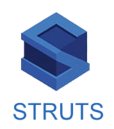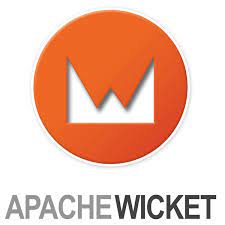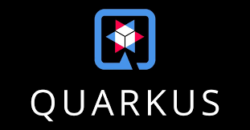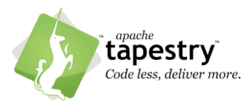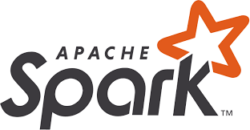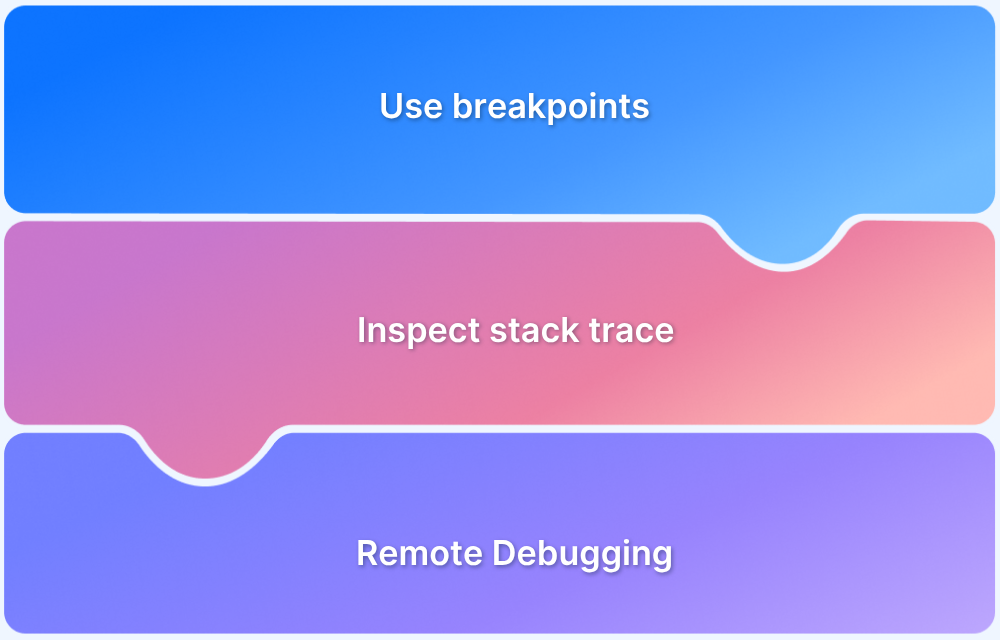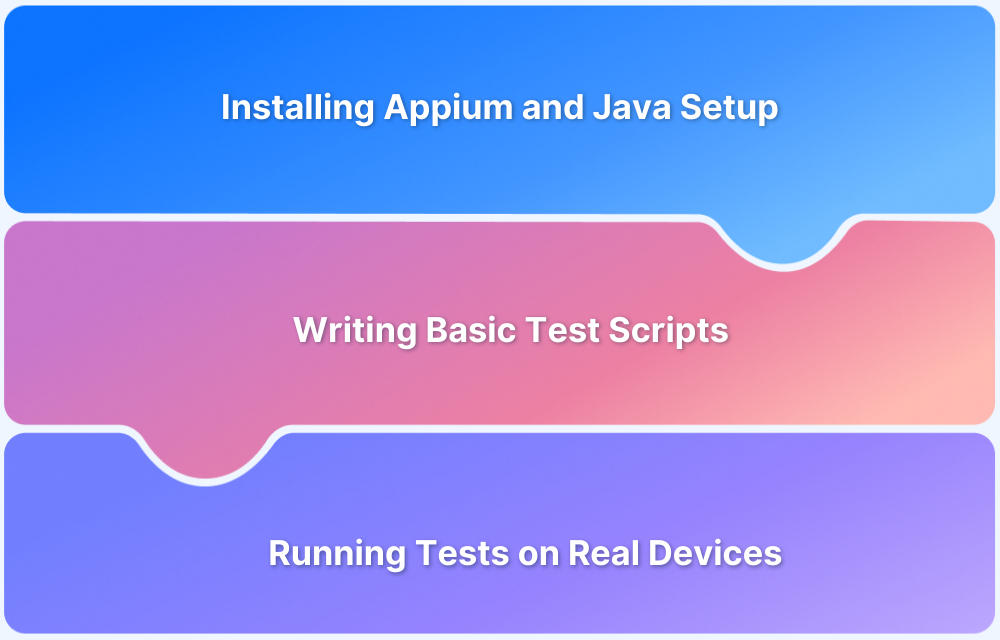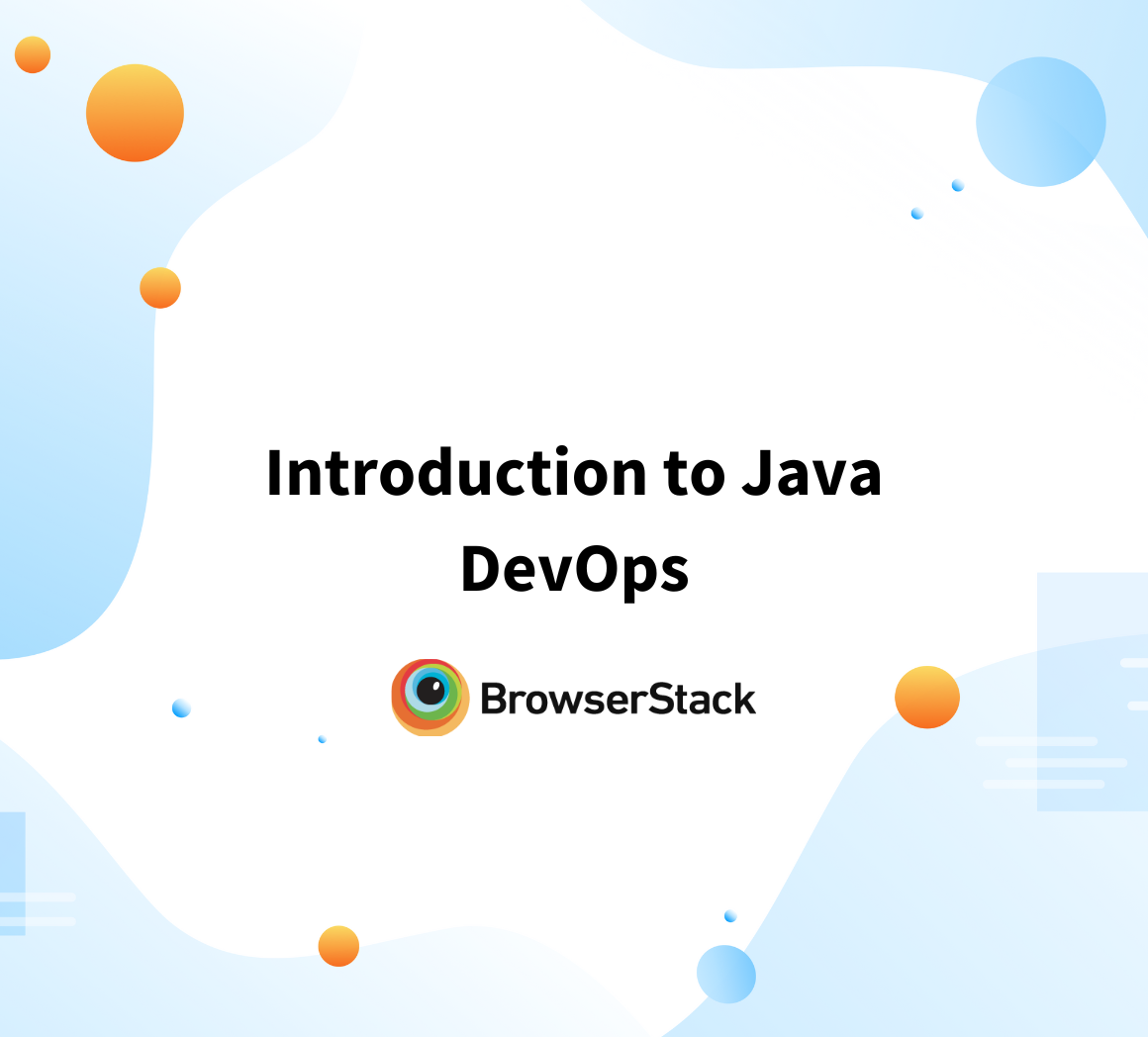Top 15 Java Frameworks for Modern Application Development
By Shweta Jain, Community Contributor - January 2, 2025
Java has long been a foundational language in software development, recognized for its stability, scalability, and cross-platform capabilities. Java remains a key player in building modern applications, whether for web services, mobile apps, or large-scale enterprise solutions.
Java remains crucial to the development of high-performance applications, offering robust frameworks that simplify and streamline the development process. Choosing the right framework can significantly impact development workflows, improve application performance, and ensure long-term maintainability.
This article discusses the importance of Java frameworks and explores how they help developers build efficient, scalable, and maintainable applications.
- What are Java Frameworks?
- Top 15 Java Frameworks for Modern Application Development
- 1. Spring
- 2. Hibernate
- 3. Struts
- 4. Apache Wicket
- 5. Vaadin
- 6. Play Framework
- 7. Dropwizard
- 8. Grails
- 9. Quarkus
- 10. Micronaut
- 11. JSF (JavaServer Faces)
- 12. JHipster
- 13. Apache Tapestry
- 14. Blade
- 15. Spark
What are Java Frameworks?
Java frameworks are collections of pre-built tools, libraries, and best practices that make building applications faster and easier. They provide a foundation for your app, handling common tasks like connecting to databases, handling security, and processing user requests. This allows developers to focus on the unique parts of their applications instead of writing repetitive code.
By offering reusable components and simplifying processes, Java frameworks help speed up development, improve productivity, and make sure apps are secure, scalable, and easy to maintain. Many popular frameworks also include features like support for web services, dependency injection, and built-in testing tools.
Whether you’re building a large enterprise system, a mobile app, or a web service, choosing the right framework can make the development process smoother and more efficient.
Top 15 Java Frameworks for Modern Application Development
Java frameworks play a crucial role in streamlining and simplifying the development of modern applications. This section explores the top 15 Java frameworks, each offering unique features and advantages to help developers build robust, scalable, and efficient applications.
1. Spring
Spring is a widely adopted framework in the Java ecosystem to simplify Java application development. It provides a comprehensive infrastructure for building enterprise applications, with features ranging from dependency injection to security and web services.
Key Features:
- Dependency Injection (DI): Promotes loose coupling, facilitating easier testing and maintenance.
- Aspect-Oriented Programming (AOP): Manages cross-cutting concerns like logging and security in a clean, modular way.
- Spring Boot: This makes it easier to set up Spring applications with minimal configuration.
- Spring Security: Integrates authentication and authorization for secure applications.
Pros:
- Extensive community support and comprehensive documentation.
- Large ecosystem with tools like Spring Boot, Spring Data, and Spring Security.
- Highly scalable and adaptable to different needs.
Cons:
- Steep learning curve for beginners.
- Configuration overhead, especially in large applications.
Read More: Java Debugging Tools and Techniques
2. Hibernate
Hibernate is a powerful, open-source Object-Relational Mapping (ORM) framework for Java. It simplifies database interactions by allowing developers to map Java objects to database tables, eliminating the need for extensive SQL code.
Hibernate provides a robust and flexible architecture, making it ideal for managing complex database operations in Java-based applications.
Key Features:
- Automatic Table Generation: Automatically creates database tables based on Java classes.
- Caching: Improves performance by reducing database access with caching mechanisms.
- Lazy Loading: Delays the loading of related data until it’s actually needed, improving initial performance.
Pros:
- Simplifies data handling with minimal boilerplate code.
- Supports a variety of relational databases.
- Great for complex queries and relationships.
Cons:
- Performance issues can arise in large-scale applications.
- Debugging complex Hibernate issues can be challenging.
3. Struts
Struts is a robust, open-source framework for developing Java-based web applications. It follows the Model-View-Controller (MVC) design pattern, enabling a clean separation of business logic, presentation layer, and application flow.
Developed by the Apache Software Foundation, Struts simplifies the creation and management of dynamic, interactive web applications.
Key Features:
- MVC Architecture: Ensures clear separation of concerns between the UI, business logic, and data.
- Tag Libraries: A suite of reusable UI components to simplify web page development.
- Validation Framework: Supports validation of user inputs.
Pros:
- Well-suited for large enterprise applications.
- Strong community and solid documentation.
Cons:
- Steep learning curve.
- Falling behind in modern web development compared to newer frameworks like Spring MVC.
Read More: Unit Testing in Java with JUni
4. Apache Wicket
Apache Wicket is a modern, component-based web application framework for Java. It simplifies web development by enabling developers to create reusable, object-oriented components for dynamic user interfaces.
Wicket emphasizes simplicity and a Java-centric approach, making it ideal for developers familiar with desktop application development paradigms.
Key Features:
- Component-Based Development: Allows developers to create reusable UI components.
- Stateful Web Pages: Automatically manages the state of web pages.
- Security-Focused: Provides features like automatic encoding to ensure secure applications.
Pros:
- Simple and lightweight, with minimal boilerplate code.
- Strong focus on security and maintainability.
Cons:
- Smaller community and limited resources.
- Not as widely adopted as other frameworks.
5. Vaadin
Vaadin is a Java framework designed for building modern, business-oriented web applications with rich user interfaces. It allows you to write both client-side and server-side code in Java.
Key Features:
- Java-First: Write the entire application (both frontend and backend) in Java.
- UI Components: A comprehensive library of pre-built components for creating professional web interfaces.
- Spring Integration: Works seamlessly with Spring, making it easier to integrate with existing Spring-based applications.
Pros:
- Great for business applications that require rich UIs.
- Reduces the need for HTML/JavaScript knowledge.
- Active community and good documentation.
Cons:
- Not ideal for highly customized UIs.
- May consume more resources for simpler applications.
6. Play Framework
The Play Framework is a reactive web application framework that supports both Java and Scala. It’s built for high productivity with minimal configuration and is designed for scalable and asynchronous applications.
Key Features:
- Reactive Programming: Built for asynchronous, non-blocking I/O to handle high concurrency.
- Hot Reloading: Instantly reflects changes in code without needing to restart the server.
- WebSockets Support: Makes building real-time applications straightforward.
Pros:
- High developer productivity with built-in tools and easy setup.
- Excellent for modern web apps, especially for real-time and highly concurrent systems.
Cons:
- Not suitable for very simple applications.
- Requires knowledge of reactive programming, which can be complex for new developers.
7. Dropwizard
Dropwizard is a lightweight, open-source Java framework designed for building high-performance RESTful web services and microservices. It combines well-known, production-ready libraries into a cohesive platform, enabling developers to quickly create reliable and scalable services.
Key Features:
- Microservices-Friendly: Optimized for building RESTful APIs and microservices.
- Out-of-the-Box Tools: Includes built-in tools for monitoring, logging, and metrics.
- Jetty Server: Uses Jetty for high-performance HTTP handling.
Pros:
- Streamlined development for APIs and microservices.
- Provides useful monitoring and management tools right out of the box.
Cons:
- Limited in terms of full-stack web applications.
- May require additional libraries for extended features.
8. Grails
Grails is a powerful, open-source web application framework for the Java Virtual Machine (JVM) that leverages the Groovy programming language.
It is designed to boost developer productivity by adhering to the “convention over configuration” principle and seamlessly integrating with existing Java libraries and frameworks.
Key Features:
- Groovy Language: Built with Groovy, which runs on the JVM, simplifying syntax and development.
- GORM: Provides an ORM for seamless database interaction.
- Spring Integration: Leverages Spring’s flexibility and scalability.
Pros:
- Rapid application development with minimal configuration.
- Great plugin support and integration with the broader Java ecosystem.
Cons:
- Dependent on Groovy, which might not be familiar to all Java developers.
- May not be suitable for highly complex applications.
9. Quarkus
Quarkus is a modern, open-source Java framework tailored for building cloud-native applications and microservices.
Designed for Kubernetes and optimized for GraalVM and HotSpot, Quarkus delivers lightning-fast startup times and minimal memory usage, making it ideal for serverless, containerized, and edge computing environments.
Key Features:
- Native Compilation: Builds optimized native executables with GraalVM for faster startup and lower memory consumption.
- Live Reload: Provides immediate reloading during development for enhanced productivity.
- Cloud-Native: Optimized for cloud environments and containerized applications.
Pros:
- Fast startup times and low memory usage make it ideal for microservices.
- Excellent support for modern cloud-native technologies.
Cons:
- Still a relatively young framework with growing community support.
- Smaller ecosystem compared to more established frameworks.
Read More: Introduction to Java DevOps
10. Micronaut
Micronaut is a modern, JVM-based framework designed for building lightweight, cloud-native, and microservice-based applications.
Known for its fast startup times and low memory usage, Micronaut eliminates runtime reflection and embraces a compile-time dependency injection model, making it ideal for serverless and containerized environments.
Key Features:
- Ahead-of-Time (AOT) Compilation: Compiles code at build time to reduce startup times.
- Dependency Injection: Supports compile-time dependency injection, avoiding runtime reflection.
- Cloud-Native: Optimized for cloud and microservices architectures.
Pros:
- Exceptional performance with low memory usage and fast startup.
- Ideal for cloud-native and serverless applications.
Cons:
- Newer and still gaining adoption compared to more established frameworks.
- Ecosystem and tool support is not as expansive as other frameworks.
11. JSF (JavaServer Faces)
JavaServer Faces (JSF) is a robust, component-based web application framework for Java.
Developed as part of Java EE (now Jakarta EE), JSF simplifies the development of user interfaces for server-side applications by offering reusable UI components and a clean separation of business logic, presentation, and application flow.
Key Features:
- Reusable UI Components: Offers a set of pre-built UI components for UI construction.
- Built-in Navigation: Manages page navigation automatically.
- Java EE Integration: Works well with Java EE technologies for building enterprise applications.
Pros:
- Well-suited for enterprise applications that require a rich UI.
- Strong integration with Java EE.
Cons:
- Steep learning curve.
- Compared to newer frameworks, JSF feels less modern.
Read More: Assert in Java
12. JHipster
JHipster is a full-stack development platform for rapidly building modern web applications and microservices.
It combines popular frontend and backend frameworks, tools, and best practices to streamline development. With a focus on developer productivity and flexibility, JHipster is ideal for creating cloud-native and scalable applications.
Key Features:
- Full-Stack Generator: Generates both backend (Spring Boot) and frontend (Angular, React, or Vue.js) code.
- Microservices Support: Includes tools for building microservices with Spring Cloud.
- DevOps Support: Facilitates continuous integration and deployment.
Pros:
- Quick setup for full-stack applications.
- Strong support for modern technologies like microservices and modern front-end frameworks.
Cons:
- Can generate excessive boilerplate code.
- Can be overwhelming for small projects.
13. Apache Tapestry
Apache Tapestry is a component-based web application framework for Java that emphasizes simplicity, modularity, and high developer productivity.
Designed to build modern, dynamic web applications, Tapestry provides a clean separation of concerns with its component-driven approach and focus on reusable, object-oriented code.
Key Features:
- Component-Based Design: Encourages modularity with reusable UI components.
- Automatic HTML Generation: Generates HTML markup from application code.
- Java EE Integration: Works well with Java EE technologies.
Pros:
- Promotes scalability and modularity.
- Automatic handling of many web tasks, reducing the development burden.
Cons:
- Smaller community and fewer resources than larger frameworks.
- Requires a deeper understanding of the architecture.
14. Blade
Blade is a lightweight, minimalist web framework for Java, designed for building fast and efficient web applications and APIs.
Known for its simplicity and elegance, Blade emphasizes a streamlined development experience with minimal configuration and easy integration.
Key Features:
- Minimal Design: Offers a minimalistic approach, focusing only on essential features.
- Template Engine: Built-in support for rendering views with an integrated template engine.
- Routing and Middleware: Simple routing and middleware to handle HTTP requests.
Pros:
- Extremely fast and lightweight, ideal for small projects.
- Simple setup with minimal overhead.
Cons:
- Not suitable for large-scale enterprise applications.
- Smaller community compared to more established frameworks.
Read More: 15 Best Java Code Review Tools
15. Spark
Spark is a lightweight and expressive microframework for Java, designed for creating web applications and REST APIs with minimal effort.
Inspired by Sinatra (Ruby), Spark is easy to use and ideal for quick development cycles, focusing on simplicity and developer productivity.
Key Features:
- Minimal Setup: Requires minimal configuration to get started.
- REST API Support: Perfect for building lightweight RESTful services.
- Lightweight: A simple and efficient framework with a small footprint.
Pros:
- Ideal for microservices and small web APIs
- Fast setup with minimal boilerplate code.
Cons:
- Lacks many features that larger frameworks provide.
- Less suitable for complex, full-stack applications.
Key Factors to consider when choosing the right Java Framework for Development
Selecting the right Java framework is crucial for the success of your project. Here are some important things to keep in mind when making your decision:
1. Project Requirements: The kind of application you’re building will play a big role in choosing the right framework.
For instance, microservices-based applications may require frameworks optimized for distributed systems, while traditional enterprise systems or monolithic apps might benefit from established frameworks like Spring.
2. Performance: Opt for a framework that supports high performance and scalability, particularly if your application is expected to handle large volumes of traffic or complex data processing.
Lightweight frameworks like Quarkus and Micronaut have gained traction for their fast startup times and low memory consumption, making them ideal for cloud-native and microservice architectures.
3. Community and Support: A strong developer community and regular updates are vital for any framework. Look for frameworks with active communities that offer extensive resources, such as tutorials, plugins, and troubleshooting support.
Frameworks like Spring Boot have a vast ecosystem and community backing, which can significantly speed up development.
4. Learning Curve: Frameworks vary in terms of ease of use. Consider how familiar your team is with specific frameworks and the available documentation and resources. Some frameworks, such as Spring Boot, are widely used and well-documented, which may make the learning process quicker.
On the other hand, newer frameworks like Micronaut or Quarkus may have steeper learning curves but offer modern features that could benefit your application in the long run.
5. Integration Capabilities: Choose a framework that integrates easily with the other tools, databases, and services your application needs.
Whether it’s cloud platforms, third-party APIs, or legacy systems, seamless integration is key. Most modern frameworks support integration with cloud-native technologies and microservices, and tools like Spring Cloud provide cloud integration out of the box.
6. Security: Ensure the framework follows best practices for security, especially if your application handles sensitive data. Look for built-in security features such as authentication and authorization mechanisms.
Frameworks like Spring Security are well-established for providing robust, customizable security solutions, while newer frameworks are increasingly prioritizing security as part of their design.
7. Scalability and Flexibility: Choose a framework that supports growth. Your framework should be adaptable as your application evolves, particularly as business requirements change or new features are added.
Cloud-native frameworks like Quarkus and Micronaut are designed with scalability in mind, offering support for horizontal scaling and microservices architecture.
8. Maintenance and Updates: Consider the longevity of the framework you choose. Opt for frameworks that offer regular updates, bug fixes, and security patches.
A framework that’s actively maintained ensures your application stays up to date with the latest features, security improvements, and performance optimizations. Be sure to choose frameworks with a clear roadmap and ongoing support from both the community and the maintainers.
Testing and Debugging Java Applications
Testing is a critical phase in the application development lifecycle, ensuring that the code functions as intended and meets user expectations. In Java development, rigorous testing and debugging help identify and fix issues early, preventing costly errors and downtime later. A strong testing strategy ensures that the application is reliable, secure, and performs efficiently under various conditions.
1. Catching Bugs Early: The earlier you identify and address bugs, the easier and cheaper it is to resolve them. Thorough testing, including automated unit tests and continuous integration (CI) pipelines, reduces the chances of undetected issues making their way into production.
Test-driven development (TDD), which has gained traction in recent years, encourages developers to write tests before code, leading to cleaner and more reliable code from the start.
Read More: Test Driven Development (TDD) in Java
2. Ensuring Code Quality: Unit tests, integration tests, and end-to-end tests are essential for verifying that each part of the application functions correctly, both individually and when integrated with other components.
Tools like JUnit 5 (the latest version) and Mockito continue to be popular for unit testing, while TestContainers enables testing with real databases and services in isolated containers, making integration testing more robust.
3. Improving Security: Security testing, including penetration tests, vulnerability assessments, and static application security testing (SAST), ensures that the application is resilient to common threats such as SQL injection, cross-site scripting (XSS), and cross-site request forgery (CSRF).
Frameworks like Spring Security have built-in security features, but integrating security tools like OWASP ZAP or SonarQube for static code analysis can further harden the application against potential attacks.
4. Optimizing Performance: Performance testing helps ensure that the application can handle high loads and performs well under stress. Tools like JMH (Java Microbenchmarking Harness) and Gatling are popular for performance and load testing.
This phase also helps uncover issues like memory leaks, slow queries, or inefficient code paths. JVM tuning (e.g., garbage collection optimization) has become crucial in optimizing
application performance, especially for applications running at scale.
5. Debugging for Stability: Effective debugging is essential for identifying the root cause of errors or performance bottlenecks. Tools like IntelliJ IDEA and Eclipse provide powerful debugging features, including advanced breakpoints, watch variables, and code analysis.
Additionally, logging frameworks like SLF4J combined with Logback or Log4j2 are crucial for tracing and debugging production issues. Modern logging tools like ELK Stack (Elasticsearch, Logstash, Kibana) or Splunk offer powerful log aggregation and analysis capabilities to quickly pinpoint issues.
Java developers can build robust applications that deliver consistent and reliable performance by incorporating thorough testing and debugging practices such as TDD, automated testing, security testing, and JVM performance tuning.
Continuous integration and continuous delivery (CI/CD) pipelines should also be integrated into the workflow to ensure that every code change is automatically tested, deployed, and monitored for issues.
Challenges in Testing Modern Java Applications (and How to Solve Them)
Testing modern Java applications can be a complex task, especially as software systems grow larger and more distributed. As architectures evolve, new challenges arise. Here’s a breakdown of common testing hurdles developers face today, along with practical solutions:
1. Scalability of Tests
Modern Java applications are built to scale, and testing them must scale too. Traditional local testing environments often struggle to mimic the demands of real-world applications.
Solution: Use cloud-based platforms like BrowserStack Automate to run tests in parallel across thousands of real browsers and devices. This ensures your tests scale effortlessly as your application grows.
2. Maintaining Test Reliability
Flaky tests are a common problem when dealing with dynamic Java applications. They consume time and reduce confidence in the test suite.
Solution: Implement robust test design practices like proper data isolation and mocking. Tools like BrowserStack Automate allow you to test on consistent environments, reducing flakiness and increasing test reliability.
3. Testing Distributed Architectures
Distributed systems involve multiple services communicating across networks, making it complex to test the entire data flow and functionality.
Solution: Use tools like Docker Compose to replicate the application stack locally or Kubernetes for more complex systems. Combine this with BrowserStack to test real user flows across distributed web applications, ensuring all components work seamlessly together.
4. Cross-Platform and Cross-Browser Compatibility
Java applications must function consistently across a wide range of platforms, devices, and browsers, which is hard to replicate locally.
Solution: BrowserStack Automate enables you to test your application on 3,000+ real devices and browsers, ensuring compatibility across all user environments without the need for setting up physical devices.
5. Testing Mobile App Components
Ensuring a seamless experience across different devices is crucial with the increasing prevalence of Java-based mobile applications.
Solution: Use BrowserStack App Automate to test mobile apps on real Android and iOS devices, ensuring your app performs flawlessly across devices and OS versions.
6. Speed of Testing
As release cycles shorten, testing needs to keep up without sacrificing quality.
Solution: Parallel testing on platforms like BrowserStack Automate helps execute multiple tests simultaneously, significantly reducing testing time and speeding up releases.
7. Debugging and Troubleshooting
Identifying and resolving issues in large, complex Java applications can be time-consuming, especially when bugs occur on specific devices or browsers.
Solution: Use BrowserStack to capture detailed logs, screenshots, and videos of test runs, enabling faster debugging and improving the overall efficiency of your testing process.
Simplify Testing for Java Applications with BrowserStack Automate
Testing Java applications can be a lengthy and complex process, especially when you need to ensure that they work across a variety of browsers, devices, and operating systems. BrowserStack Automate and App Automate simplify this process by offering a cloud-based platform for automating tests on web and mobile apps.
Here’s how it can help streamline your testing efforts:
- Cross-Browser Testing: BrowserStack allows you to test your Java applications on different browsers and versions without the hassle of setting up complicated testing environments. This ensures that your application will work smoothly across multiple platforms and reduces the time spent on manual testing. You can quickly verify functionality on various browsers, ensuring consistency in user experience.
- Real Device Testing: Testing Java mobile apps on real devices is crucial for getting accurate results. Instead of relying on emulators, BrowserStack provides access to a wide range of real mobile devices, enabling you to test how your app behaves on actual hardware. This helps identify issues that may only appear on physical devices, such as touch responsiveness and device-specific bugs.
- Parallel Testing: With BrowserStack’s parallel testing feature, you can run multiple tests at the same time across different devices, browsers, and operating systems. This speeds up the testing process and allows you to catch issues faster. Running tests in parallel reduces the overall time spent on testing, enabling quicker identification and resolution of problems.
- Seamless Integration: BrowserStack integrates effortlessly with popular Java testing frameworks like JUnit, TestNG, and Selenium, so you can automate your testing scripts without any hassle. Incorporating BrowserStack into your CI/CD pipeline ensures that tests run continuously throughout the development cycle, leading to faster releases and higher-quality applications.
- No Setup Required: Unlike traditional testing environments that require lengthy setups, BrowserStack provides instant access to a wide variety of devices and browsers on its cloud platform. You don’t need to spend time configuring local testing environments or managing devices; just log in, choose the device or browser you want to test on, and you’re ready to go.
Conclusion
Choosing the right Java framework is key to building efficient, scalable, and maintainable applications in today’s fast-moving tech landscape. Each Java framework offers features to help you tackle different projects, whether a web app, enterprise solution, or mobile application.
The framework you choose will depend on several factors, such as your project’s specific needs, your team’s expertise, and how you expect the application to grow over time. With the right framework, developers can focus on what matters most, which is creating high-quality, user-friendly applications that help drive business success.
Once your app is ready using a preferred Java framework, ensure it performs flawlessly with BrowserStack Automate and App Automate. Test web and mobile apps on real devices and browsers for reliable, fast, and high-quality releases.

